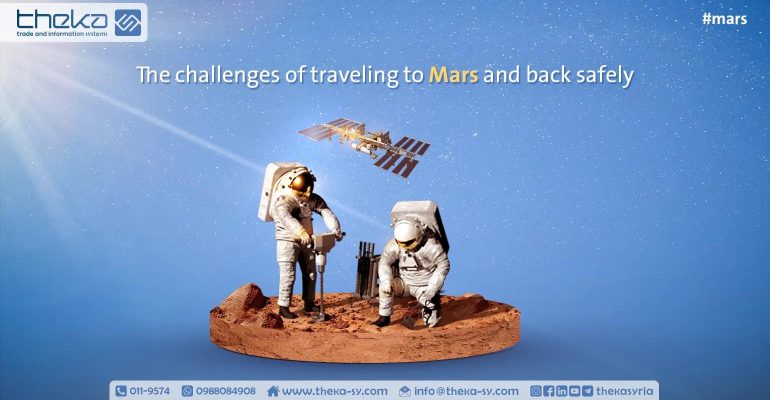The challenges of going to Mars and back safely

The challenges of going to Mars and back safely
The challenges of going to Mars and back safely
There are many things that humanity must overcome before launching any trip to Mars.
NASA and SpaceX, which work closely together on missions to the International Space Station, represent the biggest challenge for a mission to Mars, including spacecraft, people, fuel and supplies, and payload mass.
Travel crises
The payload mass is usually just a small percentage of the total mass of the launch vehicle, for example the Saturn V rocket that launched the Apollo 11 mission to the moon weighed 3,000 tons.
However, it could launch 140 tons (5 percent of the initial launch mass) to low Earth orbit, and 50 tons (less than 2 percent of the initial launch mass) to the Moon.
Mass limits the size of a spacecraft and what it can do in space. Each maneuver costs hundreds of liters of fuel to power the rocket engines. Currently, this fuel must be transported into space aboard the spacecraft.
SpaceX’s plan is to refuel a manned Starship in space with a separate fuel tanker. This means that much more fuel can be carried into orbit than can be carried in a single launch.
Fuel Challenge
Another challenge is closely related to fuel. Missions that send uncrewed spacecraft to exoplanets often travel intricate paths around the sun.
The missions use so-called gravity-assist maneuvers to effectively fly around different planets to gain enough momentum to reach their target.
These maneuvers save a lot of fuel. But missions can take years to reach their destination.
Earth and Mars have nearly circular orbits. The maneuver known as the Hohmann Transfer is the most fuel-efficient way to travel between two planets.
Hohmann’s transition between Earth and Mars takes about 259 days (between eight to nine months). It is possible about every two years due to the different orbits around the Sun, Earth and Mars.
A spacecraft can reach Mars in a shorter time. But it costs more fuel to do so.
Safe landing
Another issue is how to land safely. A spacecraft entering Earth can use the clouds generated by the interaction with the atmosphere to slow down their speed. This allows the vehicle to land safely on Earth’s surface (provided that it can handle the relevant heat).
But the atmosphere on Mars is 100 times thinner than the atmosphere on Earth. This means less possibility of dragging, so it is not possible to land safely without some kind of assistance.
Some missions have landed on airbags, such as NASA’s Pathfinder mission. Others have used thrusters, as happened with NASA’s Phoenix mission as well.
Life on Mars
A Martian day lasts 24 hours and 37 minutes, but the similarities to Earth stop there. Which means that the thin atmosphere on Mars cannot retain heat as it does on Earth.
Therefore, life on Mars is characterized by significant extremes of temperatures during the day and night cycle, with a maximum temperature of 30 degrees Celsius on Mars.
But its lowest temperature is minus 140 degrees Celsius, and its average temperature is minus 63 degrees Celsius, while the average winter temperature in the Earth’s Antarctica is about minus 49 degrees Celsius.
And so we need to be very selective about where we choose to live on Mars and how we manage temperature at night.
The gravity on Mars is 38 percent of Earth’s, so it feels lighter. But air consists mainly of carbon dioxide with a small percentage of nitrogen, so it is completely unbreathable.
SpaceX plans to launch several cargo flights, including critical infrastructure such as greenhouses, solar panels, and a fuel production facility for return missions to Earth.
And life on Mars would be possible. Many simulation experiments were conducted on Earth to see how people would deal with such an existence.
Back to Earth
The final challenge is the journey back and the people safely back to Earth. The Apollo 11 mission entered the Earth’s atmosphere at a speed of about 40,000 kilometers per hour, which is slightly less than the speed required to escape from Earth’s orbit.
The spacecraft returning from Mars will have return speeds between 47,000 and 54,000 kilometers per hour. That depends on the orbit you’re using to reach Earth.
The speed in low Earth orbit can slow to about 28,800 kilometers per hour before entering our atmosphere. But the vehicle needs additional fuel to do so.
It must be ensured that the astronauts are not killed by the equivalent force of gravity or burned due to excessive heat.
It is noteworthy that these challenges are just some of the challenges facing the Mars mission. It can be argued that all the technical requirements to achieve this are in place, but we need to spend more time and money to solve all these challenges.


